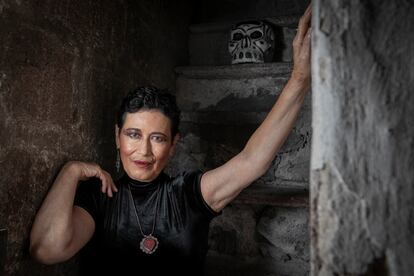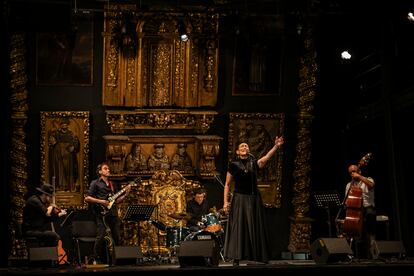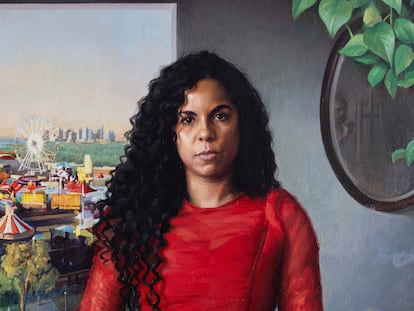Mexican singer Jaramar Soto’s intense passion for rescuing the voices of women in baroque music
The winner of a Latin Grammy in the classical music category, she has dedicated three decades of her artistic career to exploring the richness of ancient music, the Sephardic tradition, and its fusion with Mexican musical legacies


This interview almost didn’t happen. And the blame lies with Mexico City’s traffic. Summer in the Mexican capital is more like a wet autumn, with cold and stormy afternoons. The consequence of this — in addition to the city being flooded — is hellish traffic jams. Or rather: the prelude to hell for anyone who wants to move around this enormous city to keep an appointment… or an interview.
The conversation with folk singer Jaramar Soto was scheduled an hour before she was set to give a concert in the Divino Narciso auditorium of the Claustro de Sor Juana University, located in an imposing 16th-century convent in the heart of the city. But for hours, this journalist was stuck in traffic and bogged down by the rain. It was Soto’s generosity that allowed the conversation to take place in the auditorium’s dressing room following her performance.
The artist, who was born in Mexico City in 1954, sips from a shot glass of tequila. “It was also quite difficult for us to get here, we arrived half-an hour later than we had planned,” she says, with a sweet smile, after accepting the apology from EL PAÍS.
Soto is warm, open and harmonious while talking. Tonight, she entranced an audience, which gave her a standing ovation after a concert composed of a beautiful repertoire with songs from the 17th century. Much of this Baroque music was written by women who sang about the pain of lost loves who went off to sea. They sang of nostalgia, melancholy and passion. Many of them are also — as often happens — long forgotten.
Soto began singing 30 years ago in Guadalajara, where she had moved to study design. She explains that she came across 17th-century music “by pure chance.” At that time, she sang in cultural centers, “or wherever she could.” A friend of her father, who was a theater director, staged works of Spanish classical drama. On one occasion, when he was about to stage a new production, he asked Soto to open the show with “a little concert of old Spanish songs.” She said yes. “Although, obviously, I had no idea about old Spanish songs,” she laughs.
Her friend lent her several records. And that’s when she made a “shocking discovery.” The singer remembers that the people who listened to her were usually amazed when they heard her sing that Baroque music: “How wonderful! This sounds really good, it’s what you have to sing.” She recalls these positive comments while sipping her tequila. “For me, it was love at first sight. I said: ‘These 17th-century songs are beautiful,’” the artist sighs.

She knew, there and then, that she had to immerse herself in that musical world. She wanted to make that journey into the past through music, to meet artists — many of them women — who had fallen into oblivion and revive, so to speak, their talent. “I came to this music in an absolutely intuitive way, not academic. And that was a huge advantage. I had studied singing for many years, but I dedicated myself to the new Mexican [genre], which was what we all sang at that time. It was the time of new [kinds of] singing, of composing songs. But singing this other music was a revelation for me and I didn’t stop doing it,” Soto explains.
The artist didn’t stop looking for old music, buying records and digging into that legacy. Soto began to expand her repertoire and discovered “the wonderful Sephardic tradition.” She fell in love with it.
Sephardic folklore impacted her because of its passionate way of singing about life. The Sephardim descend from the Jews who were expelled from Spanish territories in 1492. Still, they maintained their Iberian traditions, including their songs of love and nostalgia for what they had forcibly left behind. “As I came from another type of music — and as I had been nourished by listening to diverse music — I decided to start my own project, as a soloist, at the beginning of the 1990s. I said that [my focus] had to be about those songs, but with the freedom to transform them, to manipulate them,” she explains.
It was along these lines that she recorded her first album, in which she combined acoustic instruments with synthesizers and a repertoire of old songs. And how did Soto find them? Well, the Sephardic community in Mexico heard her work and they practically adopted her. They began to share their musical legacy with her, in a country where, until she began her career, there was no one dedicated to protecting that specific musical legacy. She subsequently copied old records, recordings, and medieval songs.
Soto also consulted academics dedicated to studying ancient lyric poetry, such as María Frenk, who directed the faculty of music at the National Autonomous University of Mexico (UNAM). She gradually built up an enormous collection of books and documents. “Each of my albums is thematic. They’re conceptual albums; I look for something very precise to develop the repertoire of each work. The first, titled Entre la pena y el gozo (”Between pain and joy”), [consists of] songs of love and heartbreak. I worked a lot with poetry, because my development was very close to poets, writers, people from the performing arts,” she notes.
Much of Soto’s work has been refined to focus on what she wants to say in each of her albums. Her most recent collection — Todas las naves del mundo (“All the ships in the world”) — was dedicated to fusion. “I wanted to start from the music of the time of the Catholic Monarchs, which was a multicultural era, thanks to the Arabs (both Muslim and Christian), the Jews, the [European] Christians, with music that fed off of each other, with melodies, scales, wonderful texts. They’re traveling songs of mestizaje (the notion of being mixed origin, in the Latin American context), starting with the Spanish 13th century, going through poems by [New Spain writer] Sor Juana Inés de la Cruz and then through Mexican mestizo music, which is a mixture of all that. The heritage is very clear,” she affirms.
She has found that heritage, for example, in the son huasteco — popular music from the Huasteca region of Mexico, which includes the states of Veracruz, Tamaulipas, San Luis Potosí, Puebla and Hidalgo. “It’s closely related to the Spanish Renaissance folías… it has the same harmonic progression. It’s always very exciting for me to find verses from Sephardic songs, or old ballads in the peteneras (flamenco beats) of Veracruz, in the songs of Oaxaca, in the lloronas,” the singer explains, the latter referring to Mexican folk songs derived from the legend of La Llorona, a weeping ghost who mourns her children.

Soto’s life was destined to be that of a dancer or painter, due to her parents’ professions: her father, Alfonso Soto, was a museographer, while her mother, Alma Rosa Martínez, was a dancer. “I surprised them with this idea that I was going to dedicate myself to music,” Soto laughs. “Music is the backbone of my life.” For her, music and poetry always go hand-in-hand.
During the concert at the Divino Narciso auditorium, Soto delights a devoted audience with a repertoire of old songs. Some contain lyrics by 15th-century poets like Florencia del Pinar, one of the few lyrical creators who has survived oblivion. “She wrote despite everything and prevailed,” Soto says. The singer has given voice to those women, to songs of lovers from the coasts of Galicia, who mourned the departure of their loved ones, thrown into a dark and stormy sea. It was unclear if they would ever return.
Soto understood that she had to rescue the courage of those women and make an effort to compose her own works. At first, she didn’t dare. “I convinced myself that I could… I [defined] myself as someone who can make songs,” she emphasizes.
The artist’s work was recognized in 2016 with a Latin Grammy in the classical music category for her album El Hilo Invisible: Cantos Sefaradíes (“The Invisible Threat: Sephardic Songs”). She recorded this in collaboration with Cuarteto Latinoamericano, an iconic string quartet. “It hasn’t been easy, because this industry is very complicated. [It has been even more difficult] to maintain my independence, doing exactly what I want to do, with creative freedom, because I decide my repertoire, the content, the image,” she says.
Soto will complete three decades of her musical career this year. She tries to maintain her identity, her own brand, so that people recognize her sensitive, beautiful work, which deals with love and heartbreak, as well as life and happiness. “The fact that I’ve remained very firmly on that path has been an advantage. Yes, I compete against the entire industry… but I don’t compete with projects that resemble me,” she clarifies. “I had to dare to do many things. And I made it. At this point, I no longer doubt it,” she concludes, smiling as she takes another sip from her shot glass of tequila.
In the beautiful space where she has given her performance, another woman — Sor Juana Inés de la Cruz, one of the most important authors in the Spanish language, who lived in the 17th century — also broke the chains that bound her creativity.
Sign up for our weekly newsletter to get more English-language news coverage from EL PAÍS USA Edition
Tu suscripción se está usando en otro dispositivo
¿Quieres añadir otro usuario a tu suscripción?
Si continúas leyendo en este dispositivo, no se podrá leer en el otro.
FlechaTu suscripción se está usando en otro dispositivo y solo puedes acceder a EL PAÍS desde un dispositivo a la vez.
Si quieres compartir tu cuenta, cambia tu suscripción a la modalidad Premium, así podrás añadir otro usuario. Cada uno accederá con su propia cuenta de email, lo que os permitirá personalizar vuestra experiencia en EL PAÍS.
¿Tienes una suscripción de empresa? Accede aquí para contratar más cuentas.
En el caso de no saber quién está usando tu cuenta, te recomendamos cambiar tu contraseña aquí.
Si decides continuar compartiendo tu cuenta, este mensaje se mostrará en tu dispositivo y en el de la otra persona que está usando tu cuenta de forma indefinida, afectando a tu experiencia de lectura. Puedes consultar aquí los términos y condiciones de la suscripción digital.
More information
Archived In
Últimas noticias
Iranian women are also defying the taboo of riding motorcycles (and without a license)
David Bowie, the galactic thinker who encouraged us to break new ground
John Berger and the loss of rural culture
From police officer to bloodthirsty kidnapper: Terror in Mexico during the years of ‘The Ear Chopper’
Most viewed
- David King, chemist: ‘There are scientists studying how to cool the planet; nobody should stop these experiments from happening’
- Reinhard Genzel, Nobel laureate in physics: ‘One-minute videos will never give you the truth’
- Oona Chaplin: ‘I told James Cameron that I was living in a treehouse and starting a permaculture project with a friend’
- Mexico completes its trade shift with the entry into force of tariffs on China and countries without trade agreements
- Sinaloa Cartel war is taking its toll on Los Chapitos










































